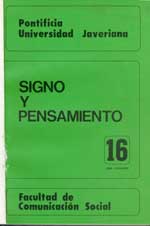Abstract
Acharles Senders Peirce se le reconoce como el “otro Padre” –junto con Saussure- de la teoría general de los signos. Sin embargo, con frecuencia se reduce su trabajo semiótico a la enunciación superficial de la estructura triádica del signo y a la clasificación un tanto obtusa y rebuscada de las clases de signos. Si bien es cierto que estos aspectos son interesantes, solo se puede comprender su densidad y sentido al dar a la semiótica peirceana su dimensión ontológica. El pensamiento arquitectónico propio de Pierce se caracteriza por la búsqueda de cientos, pocos pero solidos que fundamenten su construcción filosófica. Estos fundamentos son las categorías universales del ser que se proyectan, en un nivel diferente y con distintas dimensiones, en el signo, esto es, en el signo como “representación”, como fenómeno general que opera en la naturaleza. Al autor lre interesa aquí sistematizar la descripción general del signo- sus elementos y clasificación- partiendo de los presupuestos generales de la Teoría Triádica de las Categorías del Ser.This journal is registered under a Creative Commons Attribution 4.0 International Public License. Thus, this work may be reproduced, distributed, and publicly shared in digital format, as long as the names of the authors and Pontificia Universidad Javeriana are acknowledged. Others are allowed to quote, adapt, transform, auto-archive, republish, and create based on this material, for any purpose (even commercial ones), provided the authorship is duly acknowledged, a link to the original work is provided, and it is specified if changes have been made. Pontificia Universidad Javeriana does not hold the rights of published works and the authors are solely responsible for the contents of their works; they keep the moral, intellectual, privacy, and publicity rights.
Approving the intervention of the work (review, copy-editing, translation, layout) and the following outreach, are granted through an use license and not through an assignment of rights. This means the journal and Pontificia Universidad Javeriana cannot be held responsible for any ethical malpractice by the authors. As a consequence of the protection granted by the use license, the journal is not required to publish recantations or modify information already published, unless the errata stems from the editorial management process. Publishing contents in this journal does not generate royalties for contributors.


